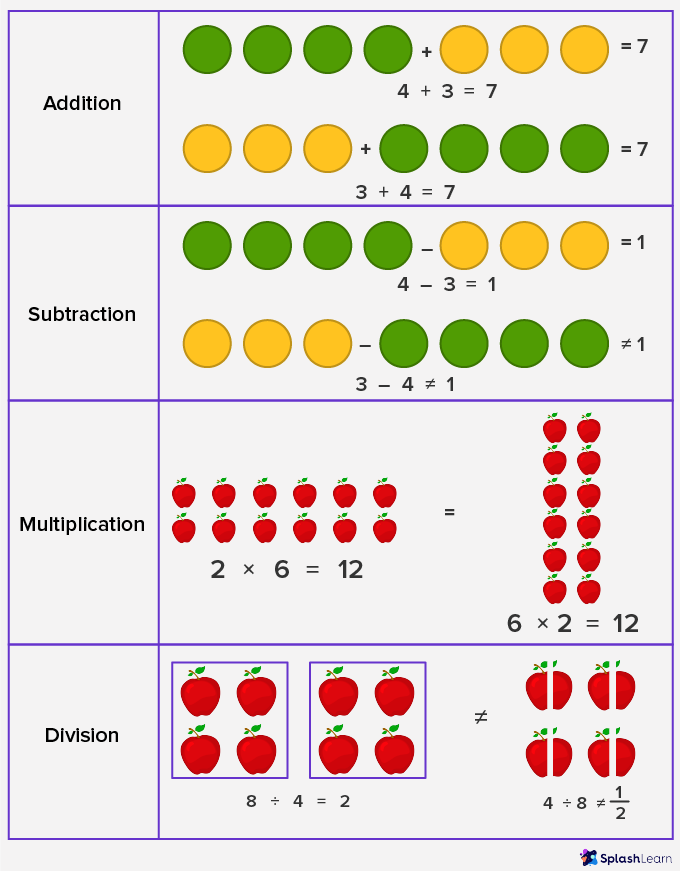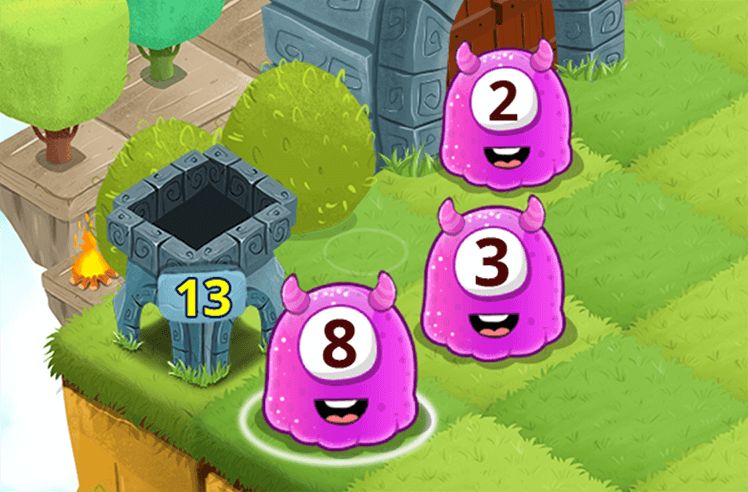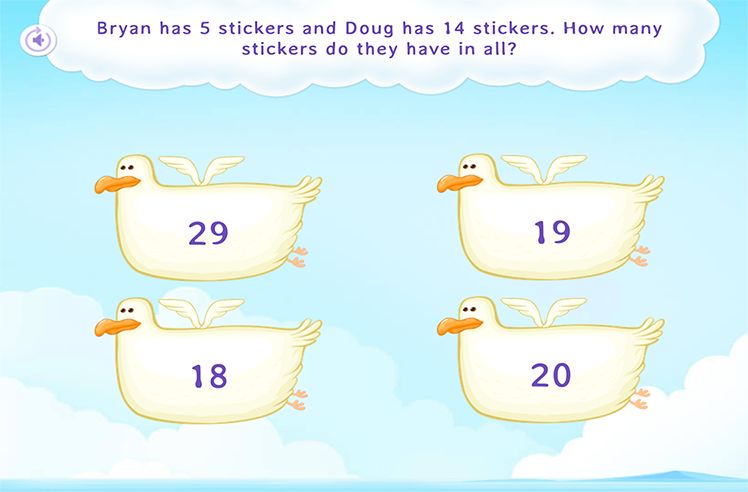Commutative Property
The commutative property states that the numbers on which we operate can be moved or swapped from their position without making any difference to the answer. The property holds for Addition and Multiplication, but not for subtraction and division. Let’s see.

The above examples clearly show that the commutative property holds true for addition and multiplication but not for subtraction and division. So, if we swap the position of numbers in subtraction or division statements, it changes the entire problem.
So, mathematically commutative property for addition and multiplication looks like this:
Recommended Games
Commutative Property of Addition:
a + b = b + a; where a and b are any 2 whole numbers
Recommended Worksheets
Commutative Property of Multiplication:
a × b = b × a; where a and b are any 2 non zero whole numbers
Use Cases of Commutative Property
- Myra has 6 apples and 2 peaches. Kim has 2 apples and 6 peaches. Who has more fruits?
Even if both have different numbers of apples and peaches, they have an equal number of fruits, because 2 + 6 = 6 + 2.
- Sara buys 3 packs of buns. Each pack has 4 buns. Mila buys 4 packs of buns and each pack has 3 buns. Who bought more buns?
Even if both have different numbers of bun packs with each having a different number of buns in them, they both bought an equal number of buns, because 3 × 4 = 4 × 3.
Solved Examples on Commutative Property
Example 1: Fill in the missing numbers using the commutative property.
- _________ + 27 = 27 + 11
- 45 + 89 = 89 + _________
- 84 × ______ = 77 × 84
- 118 × 36 = ________ × 118
Solution:
- 11; by commutative property of addition
- 45; by commutative property of addition
- 77; by commutative property of multiplication
- 36; by commutative property of multiplication
Example 2: Use 14 × 15 = 210, to find 15 × 14.
Solution:
As per commutative property of multiplication, 15 × 14 = 14 × 15.
Since, 14 × 15 = 210, so, 15 × 14 also equals 210.
Example 3: Use 827 + 389 = 1,216 to find 389 + 827.
Solution:
As per commutative property of addition, 827 + 389 = 389 + 827.
Since, 827 + 389 = 1,216, so, 389 + 827 also equals 1,216.
Example 4: Use the commutative property of addition to write the equation, 3 + 5 + 9 = 17, in a different sequence of the addends.
Solution:
3 + 9 + 5 = 17 (because 5 + 9 = 9 + 5)
5 + 3 + 9 = 17 (because 3 + 5 = 5 + 3)
5 + 9 + 3 = 17 (because 3 + 9 = 9 + 3)
Similarly, we can rearrange the addends and write:
9 + 3 + 5 = 17
9 + 5 + 3 = 17
Example 4: Ben bought 3 packets of 6 pens each. Mia bought 6 packets of 3 pens each. Did they buy an equal number of pens or not?
Solution:
Ben bought 3 packets of 6 pens each.
So, the total number of pens that Ben bought = 3 × 6
Mia bought 6 packets of 3 pens each.
So, the total number of pens that Ben bought = 6 × 3
By the commutative property of multiplication, 3 × 6 = 6 × 3.
So, both Ben and Mia bought an equal number of pens.
Example 5: Lisa has 78 red and 6 blue marbles. Beth has 6 packets of 78 marbles each. Do they have an equal number of marbles?
Solution:
Since Lisa has 78 red and 6 blue marbles.
So, the total number of marbles with Lisa = 78 + 6
Beth has 6 packets of 78 marbles each.
So, the total number of marbles with Beth = 6 × 78
Clearly, adding and multiplying two numbers gives different results. (Except 2 + 2 and 2 × 2.
That is, 78 + 6 ≠ 6 × 78
So, Lisa and Beth don’t have an equal number of marbles.
Practice Problems On Commutative Property
Commutative Property
Which of the following represents the commutative property of addition?
According to the commutative property of addition, the sum remains the same on interchanging the addends. That is, a + b = b + a.
Which of the following represents the commutative property of multiplication?
According to the commutative property of multiplication, the product remains the same on interchanging the multiplicand and multiplier. That is, a × b = b × a.
Which of the following expressions will follow the commutative property?
Commutative property does not hold true for division and subtraction.
Choose the set of numbers to make the statement true.
5 + _____ = 4 + ______
5 + 4 = 4 + 5
(by commutative property of addition)
Frequently Asked Questions On Commutative Property
Can you apply the commutative property of addition/multiplication to 3 numbers?
Yes. By definition, commutative property is applied on 2 numbers, but the result remains the same for 3 numbers as well. This is because we can apply this property on two numbers out of 3 in various combinations.
Which operations do not follow commutative property?
Commutative property cannot be applied to subtraction and division.
What is the associative property of addition (or multiplication)?
For which all operations does the associative property hold true?
The Associative property holds true for addition and multiplication.
What is the distributive property of multiplication?
By the distributive property of multiplication over addition, we mean that multiplying the sum of two or more addends by a number will give the same result as multiplying each addend individually by the number and then adding the products together. That is,
a × (b + c) = (a × b) + (a × c) where a, b, and c are whole numbers.




































